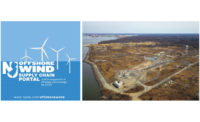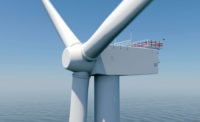Work will start in June on a $2.2 billion, 416-mile high voltage transmission line through Wyoming, Colorado and Utah, following a federal notice to proceed issued on May 26. The 500-kV line is part of a larger $6-billion transmission expansion across the western U.S. planned by utility giant PacifiCorp, with operations in six states. Other western projects also are moving faster through the U.S. Interior Dept. pipeline.
“Approving large-scale transmission projects like this are key to bringing renewable energy online while creating good-paying union jobs,” said Tracy Stone-Manning, director of Interior's Bureau of Land Management, which approved the PacifiCorp project that is set to have a 1,325-person construction workforce.
The Portland, Ore., utility company is owned by investment firm Berkshire Hathaway.
The new line will add 2 GW of capacity for traditional and renewable energy, including advanced nuclear and energy storage projects proposed in Wyoming, Gary Hoogeveen, CEO of Rocky Mountain Power, PacifiCorp’s service division in Utah, Wyoming and Idaho, said in a statement.
Permitting for parts of the Energy Gateway expansion has been underway since 2007. “It has taken 15 years to build out the system,” Hoogeveen said. “We’re not done—we’ve probably got another decade to go.”
The firm gained Wyoming regulators' approval May 10 for the Gateway projects.
PacifiCorp plans to reduce greenhouse gas emissions 74% from 2005 levels by 2030 and 98% by 2050 by investing and modernizing its transmission system, increasing renewable energy and storage and investing in advanced nuclear resources.
The Gateway South project gained final environmental approval in December 2016. BLM worked with PacifiCorp, the National Fish and Wildlife Foundation, Wyoming Wildlife and Natural Resource Trust and other state and federal officials to establish an “innovative and collaborative approach” to mitigate disruptions to wilderness lands and construction impacts to the Greater sage-grouse.
The line begins in south central Wyoming at the Aeolus substation near Medicine Bow, extending southwest across public and private lands to northwestern Colorado and terminating at the Clover substation in Mona, Utah. It will be built on guyed steel lattice and self-supporting steel lattice towers ranging in height from 140 ft to 190 ft. The spans will be placed between 1,000 ft and 1,500 ft apart. The line should be in service in 2024, PacifiCorp said.
The utility plans to add more than 3.7 GW of new wind power by 2040 in Wyoming and five other western states it serves. These would replace energy from a total of 19 regional coal-fired power plants set to be retired.
Western Pipeline Expands
BLM also released a draft EIS for the 520-mile, two 500-kV line SunZia Southwest transmission project between central New Mexico and central Arizona. The project would transport up to 4.5 GW of power from New Mexico to markets in Arizona and California, the agency said.
Developer SunZia partnered with Pattern Energy to build transmission to transport 3 GW of wind energy from the latter’s planned wind farm in New Mexico.
The agency is also starting environmental review of the 214-mile, 500 kV Cross-Tie project between Robinson Summit, Nev., and Clover, Utah. The $667-million project is under development by TransCanyon, an independent transmission firm also owned by Berkshire Hathaway.
The company plans to have the project onl ine in 2026 with construction beginning in 2023. POWER Engineers is providing providing preliminary engineering support for the permitting effort, says a TransCanyon spokesman. Also under BLM review now is the 423-mile Greenlink West project between Las Vegas and Reno, Nev., for NV Energy. The two projects would unlock about 6.5 GW of renewable energy potential, BLM said.
Work could start next year, says developer Power Co. of Wyoming, on the $3-billion, 732-mile TransWest Express transmission project set to carry power from two large onshore wind projects in Carbon County, Wyo., to Las Vegas. The wind farm would total 3,000 turbines that would generate 900 MW of power when completed. Details on its regulatory approvals were not available.






Post a comment to this article
Report Abusive Comment